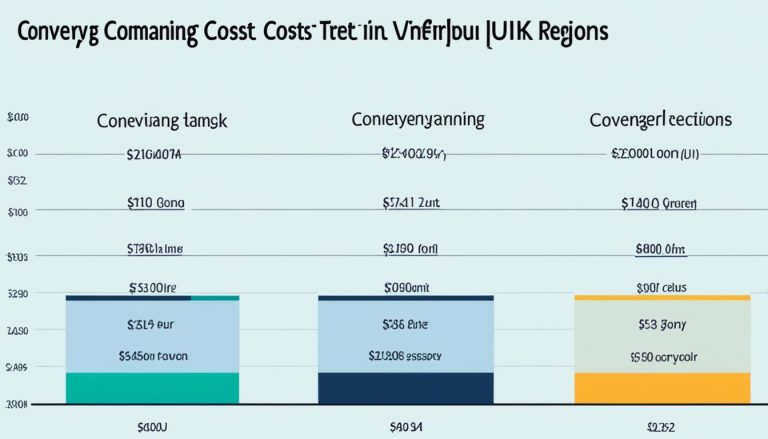Welcome to our guide on conveyancing in the UK! If you’re looking to buy or sell a property, it’s essential to understand the conveyancing process. Whether you’re a first-time buyer or an experienced investor, this comprehensive guide will provide you with all the information you need to navigate through every step of a property transaction.
So, what exactly is conveyancing? In a nutshell, it’s the legal process of transferring ownership of a property from one party to another. This involves various tasks, such as property searches, contract negotiations, and ensuring that all legal requirements are met.
Throughout this guide, we’ll break down the conveyancing process into easy-to-follow steps, giving you a clear understanding of what to expect. From finding a conveyancing solicitor to obtaining quotes and managing the associated fees and costs, we’ve got you covered.
As you read through the sections, you’ll also discover the vital role that a conveyancing solicitor plays in ensuring a smooth transaction. They provide essential legal services and guide you through the complexities of property law.
Buying or selling a property is an exciting but often overwhelming process. However, armed with the knowledge and insights from this guide, you’ll be well-equipped to navigate your way to a successful property transaction. Let’s dive in and explore the world of conveyancing in the UK together!
What is Conveyancing in Property Law?
When it comes to buying or selling property, understanding the role of conveyancing in property law is crucial. Conveyancing is the legal process that ensures a smooth and secure property transaction, protecting the rights and interests of both the buyer and the seller.
The conveyancing process involves various legal documents, searches, and checks to verify the ownership of the property and assess any potential risks or issues. It is essential to comply with all legal requirements to avoid future complications.
Conveyancing ensures that the transfer of property ownership is legally binding and protects the rights of both parties involved.
One of the key aspects of conveyancing is ensuring that the property being bought or sold is free from any encumbrances, such as liens, debts, or legal disputes. This is achieved through comprehensive property searches and investigations. These searches uncover critical information about the property, including any planning permissions, building regulations, or conservation area restrictions.
Throughout the conveyancing process, various legal documents are drafted and reviewed, such as the sale contract and the transfer deed. These documents outline the terms and conditions of the sale, including the purchase price, deposit requirements, and any additional agreements between the buyer and the seller.
Conveyancing plays a pivotal role in ensuring a transparent and lawful property transaction, providing peace of mind to all parties involved.

| Key Points | Benefits |
|---|---|
| 1. Ensures compliance with property laws and regulations | 1. Legal protection for both buyers and sellers |
| 2. Verification of property ownership and title deeds | 2. Minimizes the risk of fraudulent transactions |
| 3. Comprehensive property searches uncover potential issues | 3. Allows for informed decision-making |
| 4. Drafting and reviewing crucial legal documents | 4. Establishes clear terms and conditions of the sale |
| 5. Facilitates a smooth and secure property transaction | 5. Reduces the likelihood of future disputes |
The Conveyancing Process Step by Step
In this section, we will provide a step-by-step breakdown of the conveyancing process. Understanding the conveyancing process is essential for anyone involved in a property transaction. By knowing what to expect at each stage, you can navigate the process smoothly and ensure a successful outcome.
1. Property Searches
The first step in the conveyancing process is conducting property searches. These searches are essential to uncover any potential issues or restrictions that may affect the property. Common searches include local authority searches, environmental searches, and water and drainage searches. These searches provide valuable information about the property’s history and any potential risks.
2. Contract Negotiation
Once the property searches are complete and satisfactory, the next step is contract negotiation. This involves reviewing and discussing the terms of the contract with all parties involved, including the buyer, seller, and their respective solicitors. The goal is to ensure that the contract accurately reflects the agreed-upon terms and conditions of the property transaction.
3. Mortgage and Finance
If the buyer requires a mortgage to finance the property purchase, this step involves securing the necessary financing. The buyer will work with their mortgage lender to complete the application process and provide all required documentation. The conveyancing solicitor will liaise with the lender to ensure a smooth and timely release of funds.
4. Property Survey
Before completing the purchase, it is advisable for the buyer to conduct a property survey to identify any structural or maintenance issues. The survey report will provide valuable insights into the condition of the property, allowing the buyer to make an informed decision and potentially renegotiate the purchase price if necessary.
5. Exchange of Contracts
The exchange of contracts is a significant milestone in the conveyancing process. This involves both the buyer and seller committing to the transaction legally. Once contracts are exchanged, the buyer typically pays a deposit, which is usually a percentage of the property’s purchase price. At this stage, the transaction becomes legally binding for both parties, and neither party can withdraw without severe consequences.
6. Completion and Finalizing the Transaction
The final step in the conveyancing process is completion, where the remaining balance is paid, and legal ownership of the property is transferred to the buyer. On the agreed completion date, the buyer’s solicitor transfers the purchase funds to the seller’s solicitor, who then releases the keys. The conveyancing solicitor will handle all necessary paperwork, ensuring a seamless transfer of ownership.

By following these step-by-step guidelines, you can navigate the conveyancing process with confidence. Each stage plays a crucial role in ensuring a smooth and successful property transaction.
The Role of a Conveyancing Solicitor
In the process of buying or selling a property, a conveyancing solicitor plays a crucial role in assisting you with all the legal aspects. From ensuring the transaction is legally valid to protecting your rights as a buyer or seller, conveyancing solicitors provide essential legal services throughout the conveyancing process.
So, what exactly does a conveyancing solicitor do? Let’s take a closer look at their responsibilities:
1. Property Title Investigation and Verification
One of the key tasks of a conveyancing solicitor is to investigate and verify the title of the property you are buying or selling. This involves conducting thorough searches to confirm ownership, checking for any restrictions or easements, and reviewing legal documents related to the property.
2. Contract Drafting and Review
A conveyancing solicitor will assist in drafting or reviewing the contract for the property transaction. They ensure that all terms and conditions are fair and legally binding, protecting your interests and avoiding any potential pitfalls or disputes.
3. Liaising with Other Parties
Throughout the conveyancing process, a solicitor acts as a liaison between all parties involved, including the buyer, seller, real estate agents, mortgage lenders, and other solicitors. They facilitate communication and ensure that all necessary documents and information are exchanged promptly and accurately.
4. Property Searches and Due Diligence
Conveyancing solicitors conduct various property searches to uncover any potential issues that may affect the property or its value. These searches can include checking for planning permissions, environmental hazards, flood risks, and other factors that could impact your decision to proceed with the transaction.
5. Financial Arrangements and Transfer of Funds
A conveyancing solicitor handles the financial aspects of the property transaction, including arranging for the transfer of funds between the buyer and seller. They ensure that all financial obligations, such as payment of stamp duty and mortgage repayments, are fulfilled in a timely manner.
6. Completion and Registration
When the transaction reaches completion, your conveyancing solicitor ensures that all necessary documentation is properly executed and registered with the relevant authorities. This includes transferring the property title and notifying the Land Registry of the change in ownership.
Overall, a conveyancing solicitor provides expert legal guidance and support throughout the entire conveyancing process. Their knowledge and experience help safeguard your interests, ensuring a smooth and legally sound property transaction.

Exploring Conveyancing Fees and Costs
When it comes to the process of conveyancing, it’s important to have a clear understanding of the financial implications involved. Conveyancing fees and costs can vary depending on several factors, and being informed about these expenses is crucial to avoid any surprises along the way.
Let’s take a closer look at the various fees and costs that you may encounter during the conveyancing process:
1. Solicitor’s Fees
The solicitor’s fees are a significant component of the overall conveyancing costs. These fees cover the legal services provided by the solicitor, including reviewing contracts, conducting property searches, and handling the necessary paperwork. The solicitor’s fees can vary based on the complexity of the transaction and the expertise of the solicitor.
2. Search Fees
During the conveyancing process, various searches may be conducted to identify any potential issues or concerns with the property. These searches can include local authority searches, environmental searches, drainage searches, and more. Each search comes with its own cost, which is typically borne by the buyer.
3. Land Registry Fees
When transferring the ownership of a property, it is necessary to update the land registry. The land registry charges a fee for registering the property in the new owner’s name. The fee is determined based on the property value and is typically paid by the buyer.
4. Stamp Duty Land Tax
Stamp Duty Land Tax (SDLT) is a tax payable on properties above a certain price threshold. The amount of SDLT you will have to pay depends on the property’s value and whether you’re a first-time buyer, a second-home buyer, or purchasing an additional property. You can use the HM Revenue and Customs (HMRC) website to calculate the exact amount you will owe.
5. Disbursement Costs
Disbursements are third-party costs that your solicitor will usually handle on your behalf. These costs may include land registry fees, bank transfer fees, and fees associated with obtaining official documents or certificates relating to the property.
It’s crucial to budget for these conveyancing fees and costs to ensure a smooth transaction. Obtaining detailed conveyancing quotes from different solicitors can help you compare costs and make an informed decision regarding your budget.

| Fee/Cost | Description |
|---|---|
| Solicitor’s Fees | Covering legal services provided by the solicitor, including reviewing contracts and handling paperwork. |
| Search Fees | Costs associated with conducting property searches to identify potential issues. |
| Land Registry Fees | Fees for updating the land registry and registering the property in the new owner’s name. |
| Stamp Duty Land Tax | Tax payable on properties above a certain price threshold. |
| Disbursement Costs | Third-party costs handled by the solicitor, including land registry fees and bank transfer fees. |
Obtaining Conveyancing Quotes
When embarking on a property transaction, it’s essential to obtain conveyancing quotes from different solicitors. This allows you to compare services, fees, and expertise to make an informed decision. Here’s a step-by-step guide on how to obtain conveyancing quotes and what factors to consider:
1. Research Solicitors
Start by researching reputable solicitors who specialize in conveyancing. Look for experienced professionals with positive reviews and a track record of successful property transactions.
2. Contact Solicitors
Reach out to the solicitors you’ve shortlisted and provide them with details about your property transaction. This includes information such as the property location, type, and expected purchase/sale price.
3. Request Quotes
Ask the solicitors to provide you with detailed conveyancing quotes. Ensure that the quotes include all the essential services required for your specific transaction, such as property searches, contract review, and title transfer.
4. Compare Services and Fees
Review the conveyancing quotes from each solicitor, considering both the services offered and the associated fees. Look for transparent pricing structures and ensure that all potential costs, including disbursements, are clearly outlined.
5. Assess Expertise and Communication
Consider the expertise and communication skills of each solicitor. Look for professionals who specialize in property law and have a thorough understanding of the conveyancing process. Additionally, choose a solicitor who is responsive, proactive, and keeps you informed throughout the transaction.
6. Seek Recommendations
If you’re unsure about which solicitor to choose, seek recommendations from friends, family, or trusted professionals who have recently undergone a property transaction. Their firsthand experience can provide valuable insights.
7. Make an Informed Decision
Weigh the pros and cons of each conveyancing quote, considering the services offered, fees, expertise, and recommendations. Ultimately, choose a solicitor who not only offers competitive pricing but also inspires confidence in handling your property transaction efficiently.
By following these steps, you can navigate the process of obtaining conveyancing quotes with confidence. Remember, securing the right solicitor is crucial for a smooth and successful property transaction.
| Solicitor | Services Offered | Total Fees |
|---|---|---|
| Smith & Associates |
|
£1,500 |
| Brownson Law Firm |
|
£1,800 |
| Roberts Solicitors |
|
£1,200 |
Navigating a Property Transaction Successfully
When it comes to property transactions, it’s crucial to approach the process with a clear understanding and a strategic mindset. This section will provide you with valuable tips and advice to navigate a property transaction smoothly, ensuring a successful outcome.
Important Considerations
- Research the market: Before diving into a property transaction, take the time to research the current market trends. Understand the average property prices in the area, recent sales, and any upcoming developments that may impact the value of the property.
- Set a budget: Determine your budget and stick to it. Consider not only the purchase price but also additional costs such as stamp duty, legal fees, and any renovation expenses.
- Get professional advice: Engage the services of a reputable conveyancing solicitor who specializes in property transactions. They will guide you through each step of the process, ensuring your interests are protected.
- Review the contract: Carefully review the terms and conditions of the contract before signing. If there are any clauses or terms that you don’t understand, seek legal advice from your conveyancing solicitor.
Potential Challenges
- Chain delays: In property transactions, delays can occur due to issues with other parties involved in the chain. This can be frustrating, but it’s important to remain patient and maintain open communication with all parties.
- Legal complexities: The legal aspects of a property transaction can be complex. Ensure you have a conveyancing solicitor who will explain the legal jargon and oversee the necessary legal procedures.
- Financial setbacks: Unexpected financial setbacks, such as a mortgage application rejection or an increase in interest rates, can affect your ability to proceed with the transaction. It’s essential to have a backup plan and be prepared for any unforeseen circumstances.
By being aware of these potential challenges, you can proactively address them and minimize their impact on your property transaction.
Ensuring a Successful Outcome
Here are some tips to ensure a successful outcome:
- Communicate openly: Maintain clear and open communication with all parties involved, including estate agents, solicitors, and lenders. This will help streamline the process and address any issues promptly.
- Stay organized: Keep all relevant documents, such as property surveys, mortgage documents, and correspondence with solicitors, in a secure and easily accessible location. This will ensure you can provide the required information promptly when needed.
- Do your due diligence: Conduct thorough inspections of the property, including structural surveys and searches for any planning or environmental issues. This will help identify any potential problems before completing the transaction.
- Be prepared for negotiations: During the transaction, there may be opportunities for negotiation, such as requesting repairs or negotiating the purchase price. Be prepared to negotiate and work towards finding a mutually beneficial agreement.
With these tips in mind, you can navigate a property transaction successfully, minimizing challenges and maximizing the chances of a positive outcome.
Conclusion
In conclusion, we have delved into the world of conveyancing in the UK, providing you with a comprehensive understanding of its role in property law and the conveyancing process. Armed with this knowledge, you can confidently navigate the complexities of buying or selling property.
Throughout this article, we have highlighted the importance of engaging a conveyancing solicitor to ensure a smooth and legally compliant transaction. Their expertise and guidance are invaluable in handling property searches, negotiating contracts, and finalizing the deal.
We have also explored the financial aspect of conveyancing, shedding light on the various fees and costs involved. By understanding these expenses, you can budget effectively and avoid any surprises along the way.
With a solid foundation of knowledge on the conveyancing process, legal responsibilities, and associated costs, you are well-equipped to embark on your property journey. Whether you are a first-time buyer or an experienced seller, navigating the world of conveyancing will be more manageable and less daunting.
FAQ
How does conveyancing relate to property transactions?
Conveyancing is an essential part of property transactions in the UK. It ensures that all legal aspects are properly handled, including property searches, drafting and reviewing contracts, and facilitating the transfer of funds. It helps safeguard the interests of both buyers and sellers and ensures a smooth and legally binding transaction.
What are the key stages involved in the conveyancing process?
The conveyancing process typically involves several stages. These include property searches, reviewing legal documents, negotiating the sale contract, exchanging contracts, and completing the transaction. Each stage is crucial in ensuring a thorough and legally compliant property transaction.
What is the role of a conveyancing solicitor?
A conveyancing solicitor plays a vital role in a property transaction. They handle various legal aspects, including property searches, contract drafting and review, and ensuring compliance with legal requirements. They act as a guide and advocate for their clients throughout the conveyancing process, providing expert legal advice and minimizing potential risks.
How can I obtain conveyancing quotes?
To obtain conveyancing quotes, you can reach out to different conveyancing solicitors and provide them with the details of your property transaction. They will then provide you with an estimate of their fees and costs. It’s advisable to compare quotes from multiple sources and consider factors such as reputation, expertise, and service quality before making a decision.
What are some important considerations for a successful property transaction?
To navigate a property transaction successfully, it’s essential to stay organized, communicate effectively with all parties involved, and ensure that all necessary legal processes are followed. It’s crucial to conduct thorough property searches, review contracts carefully, and seek expert advice from a qualified conveyancing solicitor.
What is conveyancing when selling a house?
Conveyancing is the legal process of transferring ownership of a property from one party to another. When selling a house, conveyancing involves all the necessary legal steps and paperwork to ensure that the property is transferred correctly and legally to the buyer. This includes tasks such as verifying the title of the property, obtaining necessary documents and certificates, negotiating and finalizing contracts, and handling financial transactions.
What is conveyancing when buying a house?
Conveyancing is the legal process of transferring property ownership from one person to another. When buying a house in the UK, conveyancing involves detailed paperwork and searches to ensure that the property can be legally sold and purchased. This process is essential to protect both the buyer and seller’s interests and ensure that all legal obligations are met. Our conveyancing service handles all aspects of the process, from drafting contracts to conducting necessary searches and handling finances, making it easier for you to navigate this complex process.






